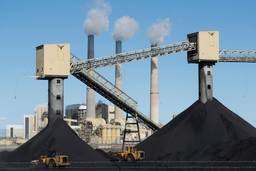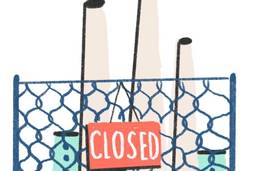“These Disasters Aren’t Natural Anymore”: A Dispatch from Puerto Rico After Maria
A conversation with Xiomara Caro Diaz of the Center for Popular Democracy about the devastation wrought by climate change and austerity.
Kate Aronoff

Several weeks ago, Puerto Rico avoided a direct hit from Hurricane Irma, which shifted north at the last minute. But Hurricane Maria hit head on, and has left a humanitarian crisis in its wake. Power on the island could be out for as long as six months, and many parts of the island have yet to be contacted.
Compounding Maria’s wreckage is the devastation brought about by ongoing austerity and an economic crisis in Puerto Rico. Last summer, Congress appointed a fiscal oversight board to reign in the island’s spending — and break union contracts and sell off public assets in the process. Just one of the board’s seven members is required to maintain a primary residence in Puerto Rico, and many see the body as the most blatant expression of the U.S. colonial presence in the commonwealth.
This reality complicates the question of what relief will look like in the coming days and months: How fast will lights get turned on? Will privatizers treat Maria as an excuse to push through their pet projects? Will the U.S. government release funds? What role — if any — will Puerto Ricans play in rebuilding their lives on the island?
To hear about this and more, I spoke by phone with Xiomara Caro Diaz, a San Juan native and the director of New Organizing Projects at the Center for Popular Democracy (CPD). In the days before the storm, she helped set up the Hurricane Maria Relief and Recovery Fund (“the Maria Fund”), housed organizationally within CPD and intended to support recovery efforts specifically in Puerto Rico’s low-income communities and communities of color. We talked about that effort, what she’s seen on the ground and what a just, democratic recovery might look like.
Kate Aronoff: Could you give me a sense of what’s happening on the ground?
Xiomara Caro Diaz: I don’t know if I have the words to describe it. It’s a mix of complete devastation and knowing that Puerto Rico is a country that’s incredibly resilient and has survived other hurricanes, metaphorically speaking: colonialism and austerity. This is not even comparable, but I’m trying to hold onto that idea.
More concretely, we’re 100 percent out of power. Most people have no phones. Because cell phones are so widespread, most people don’t have a house line anymore. I would say the majority of the country is incommunicado, locally. The day the hurricane passed, there was a moment when there were no radio stations. It’s surreal. Now there are two radio stations that are on, so those are the main forms of communication. That’s where the governor speaks and gives updates. That’s where family members call to say either, “I’m okay” or “I can’t find my family.” People have gone to the radio station physically to give information.
There are towns that up to a couple hours ago hadn’t issued any updates. Updates are an hourly thing, not a minute-by-minute thing. As of the most recent one, there are still towns that haven’t been contacted yet. There are still people waiting to be rescued on rooftops in the area around Lake Guajataca. It was mentioned today that close to 500 to 700 people were rescued Friday.
Guajataca, in particular, has been a topic of conversation, because the water dam there was breached. But the alarm that announces to the communities around it that it will be opened up did not go off. There have been reports that eight people have drowned so far. There are municipalities where not even the government of Puerto Rico knows what’s going on, and today there are going to be several official helicopter rides to connect with different places. The death toll officially is 13, with estimates that power will be out for four to six months. People are being urged not to leave their homes unless there’s an emergency. Other people have assumed a responsibility to help clean up trees and debris from the streets and help open up streets and highways.
I don’t think anybody alive has ever lived through something like this. I heard a grandmother on the radio the other day saying she lived through San Felipe II, and she said this doesn’t even compare.
Today we drove to Las Piedras to see our family and see how they are doing. The mountains looked like they were burned; trees have no leaves on them, it’s just bare wood. This just reveals how the people of Puerto Rico have been forgotten and left behind, but also have an amazing amount of resilience to live under the current political, oppressive relationship it has with the United States, and decades of economic exploitation by industry, like the pharmaceutical industry. Most recently, one big force on that front has been the market for luxury tourism and millionaires who are moving to Puerto Rico. But none of that money coming in is being invested in communities here. Driving back and looking at the mountains — where you can suddenly see things you couldn’t see before — felt like a metaphor.
We’re now seeing what it means to be economically poor and what it means to be resilient at the same time. There are already people in the streets. Hundreds of people are getting on calls every night to organize relief in the diaspora. There are already lists of 2,000 people who have signed up to come to Puerto Rico to help rebuild.
I’ve gotten some perspective, because I’ve had the privilege of having internet, and I am in an area that has signal in the capital, San Juan. There are hundreds of people still trying to connect to family members who haven’t heard from them in days. I don’t know if we’ll even grasp the magnitude of this for days or even weeks.
Kate: Have you gotten any signals from the government or from the Financial Oversight and Management Board about how they intend to respond?
Xiomara: The fiscal control board has said two things which seem pretty obvious choices: They’re revising the austerity measures and approving us to use $1 billion from our own budget for relief. Understandably, the governor has been focused on the very immediate recovery tasks at hand. There’s literally one channel of communication for the majority of Puerto Ricans, which is these two radio stations, so in terms of what they’re saying, they’re talking about rescue trips and things like that. I think it’s obvious that there should be a moratorium on the debt. There’s going to be a great need to look into deeper issues and structural inequalities that led us to here. But in the short-term, there’s a need to recognize that we need to put a stop on debt payments at a national and individual levels. We don’t vote. We don’t participate. We are a colony, and we’ve been a U.S. colony for 120 years. Puerto Rico has been used for a very long time to make money, and create taxes that allow industries to make money.
There are several conversations to be had that have to do with policy. All of these people who live in areas that were built up massively during the 1990s in places have been destroyed. Who banked on building housing in areas where they should not have been built, and which public official signed the permit on that?
There are people who lost their homes because they were wooden homes, people who stayed in their homes either because they don’t have the resources or thought they’d be okay there. Many people who live in houses that are built from cement probably suffered a lot of damage outside, but that’s a steady structure that can survive something like that. Of the at least 13 people who have passed away, three of them were sisters, all older than 60. Their house was taken with a mudslide, and they died inside the house. One sister survived. She left trying to get help.
For the past several years, Puerto Rico has been in a state of crisis because of its political and economic situation. But it is also a place of possibility, of a lot of people doing things for themselves. It just feels like it’s been the practice field for so many neoliberal policies for the last decade. This event magnifies that. It forces the question: What are the implications of austerity? This was always going to be a destructive hurricane, but people losing their lives because their house was built in a place where houses shouldn’t be built are things that could have been prevented with just policies — policies that are for people and not for profit.
Kate: How will money from the Maria Fund be spent?
Xiomara: Our affiliate in Puerto Rico is called Taller Salud, a community organization, a feminist organization that does work in several towns. The main town is Loíza. The work of Taller Salud for the last 40 years has been around reproductive rights, sexual health and violence interruption, and they’ve always been political. The women who created Taller Salud were the women who created the protocol for giving rights to women who were victims of domestic violence. They have a successful program called Acuerdo de Paz (“Peace Agreement”), and have done work with communities to interrupt violence before it escalates to death.
When I joined CPD and started connecting them with organizations in Puerto Rico, I saw Taller Salud as an organization that had been doing this work for a very long time in spite of the fact that progressive policy work was not being supported economically. To give you some context, some 90 to 95 percent of non-profits in Puerto Rico are direct-service organizations. So organizing is not something that falls within the institutional sector, but that happens outside the institutional sector in a more volunteer capacity. That’s for historical reasons: It’s a colony. A lot of foundations don’t have Puerto Rico on the map. And being about social justice in Puerto Rico means talking about liberation and our capacity to provide for ourselves as a country that has all the resources necessary to create relationships with other countries that are based in dignity. There’s a reason why that work isn’t necessarily funded the same way.
Another organization that isn’t an affiliate of CPD, but that is included in the Maria Fund, is Caño 3.7. That’s also an organization that has been doing work for decades, and gotten international recognition for the environmental justice work. It started because there were private companies interested in gentrifying an area very close to the business sector several decades ago. Communities started organizing to talk about how to guarantee their own permanence — and have a whole plan of relocating families and rebuilding the area, because it was an area where families had built in places that have a high propensity to flood. They’ve even done advocacy at the federal level. The work of Caño 3.7 has been heavily impacted by Hurricane Maria.
Kate: Why is it important to donate to the kind of grassroots work that the Maria Fund is supporting, as opposed to something like the Red Cross?
Xiomara: When I started talking to people about setting up the Maria Fund with Taller Salud, we started this conversation about the need to support grassroots organizations in Puerto Rico. Besides the immediate rebuilding, there’s a need to have an understanding about the impact of “natural” disasters — these disasters aren’t natural anymore, these disasters have been created by the politics of capitalism. We need to understand the disproportionate impacts these events have on populations that are already vulnerable because they have been excluded from policies or — really — targeted by policies.
Setting up the Maria Fund was a way of saying that rebuilding Puerto Rico is not just about putting up homes. First, it’s about guaranteeing that there will be relief. The next stage is just as important: rebuilding. What does it mean to rebuild with justice for people in Puerto Rico? There are companies that are going to try and make money off of Maria. There are industries that are going to see this as an opportunity. A lot of people are going to take advantage of the fact that there aren’t a lot of watchdogs monitoring what gets rebuilt and how. The Maria Fund is going to go to grassroots organizations in Puerto Rico that have a presence in those communities that have been working there already, and who we know and trust understand the structural inequalities those communities have faced for years.
It’s not enough to talk about the amount of people who have lost their homes in Loíza. There were 80 or 90 families there who lost their homes because of Hurricane Irma. When we talk about rebuilding Loíza, we have to ask: What do the people of Loíza really want? What does it mean to rebuild Loiza not just to be the way it was before Hurricane Maria, because — before Maria — residents were struggling with many of these issues, and were invisible to a lot of people in Puerto Rico and to the government. Asking that question requires us to provide resources to organizations that have already been listening to the people of Loíza. Taller Salud is one of them. There are others, and similar organizations in other communities.
Final decisions on how the fund is spent will be led by those local groups: Taller Salud, Caño 3.7 and any other groups we add as we start to assess where was hardest hit and what organizations can manage and help with rebuilding efforts.
Kate: What would you say are the biggest things to be looking out for in the coming days and weeks in Puerto Rico?
Xiomara: Number one, efforts to privatize Puerto Rico’s electric utility, the Puerto Rico Electric Power Authority (PREPA). It is one of the most indebted public agencies, and we don’t have a lot of collective clarity about how much money in loans was taken out in the name of the utility that wasn’t reinvested in infrastructure or working conditions. The privatization of PREPA is a conversation that was happening before now, and I’m sure it’s going to be at the top of the agenda of the Fiscal Control board. I think that people in Puerto Rico need more information to understand the importance of maintaining capital. We lost our hospitals to privatization throughout the 1990s and early 2000s. People know what that means, and I think it’ll be a top item on the agenda.
Before Maria hit, a lot of properties were being repossessed, and we were having conversations about who had an interest in homes in Puerto Rico being repossessed. A couple years ago, banks were not crazy about getting rid of their homes. But now it feels like there’s someone in the market offering money to local banks and just buying out homes in Puerto Rico. Because of the numbers of houses being repossessed, the legislature is considering approving a law to create a special courtroom just to manage eviction proceedings. Housing was already an issue in Puerto Rico — quality of housing, accessibility of decent quality housing and a huge interest in buying up the homes of people who have left. I wonder how this storm is going to change that.
This is going to be the reality under which we fight against austerity for years. Now it will be critical to develop a lens of what it will it look like to still organize people — maybe even with more urgency — to really fight for the idea that this can be a place that we can build, and that we have the capacity to rebuild. We must demand the political space to be heard, to participate in making the decisions that influence our country and to fight for economic policies that are created and designed by us and for us.
Kate Aronoff is a staff writer at The New Republic and author of Overheated: How Capitalism Broke the Planet — And How We Fight Back. She is co-author of A Planet To Win: Why We Need a Green New Deal and co-editor of We Own the Future: Democratic Socialism—American Style. Follow her on Twitter @katearonoff.








